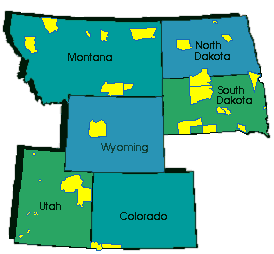Regional Information |
 Tribal Nations
Tribal Nations
NEW: Opportunity to comment on Wind River
Tribes' application for "Treatment in a Similar Manner as a State" under the Clean Air Act
TRIBAL ASSISTANCE PROGRAM (TAP)
EPA Region 8 includes 27 Federally-recognized Tribal governments located on 26 Indian Reservations.The mission of the TAP Office is to provide leadership in protecting public health and the environment within these areas of Indian country; respecting the sovereignty of each Tribe; and recognizing our Federal trust responsibilities.
The map below shows the tribal governments in Region 8 with links to either their websites or sites containing information about the tribe.

Many of the Region 8 tribes have water pollution prevention programs
funded through competitive grants awarded under Section 106 of the Clean Water
Act. Scott Clow, Director of Environmental Programs for the Ute Mountain Ute
Tribe, has compiled ten tribal water quality success stories from tribes within
our region funded under these grants and you can read them
here. ![]()
Air quality success stories for Region 8 tribes, funded under Sections 103 and 105 of the Clean Air Act, were compiled by the Southern Ute Tribe. They have been posted on the Ute Mountain Ute Environmental Programs website and you can read them here.
![]()
Opportunity to comment on Wind River Tribes' application for "Treatment in a Similar Manner as a State" under the Clean Air Act
The Northern Arapaho and Eastern Shoshone Tribes of the Wind River Indian Reservation (Tribes) have applied to EPA Region 8 for Treatment in a Similar Manner as a State (TAS) pursuant to Clean Air Act (CAA) Section 301(d) and EPA regulations at 40 CFR Part 49. Specifically, the Tribes’ CAA TAS application requests that EPA find that the Tribes are eligible to administer grants under CAA Section 105; to be treated as an “affected state” under CAA Section 505(a)(2); for approval for CAA provisions for which no separate Tribal program is required, including Sections 107(d)(3), 112(r)(7)(B)(iii), 126, 169B, 176A, and 184; and for a determination by EPA that the Tribes meet the eligibility requirements of 40 C.F.R. § 49.6.The Tribes’ CAA TAS application describes the Reservation boundary as: areas described in the 1868 Treaty of Fort Bridger, less those areas conveyed by the Tribes under the Lander and Thermopolis Purchase Acts, plus lands subsequently added to the Reservation under the Act of June 27, 1940, 54 Stat. 628.
Below, please find a copy of the public notice, plus relevant portions of the Tribes' application: the Tribes' description of the Reservation boundaries; the reference map; and their Statement of Legal Counsel.
Note: the following documents are PDF files (about PDF files)
- Wind River TAS Copy of Public Notice
- Section III. The Tribes' Authority to Regulate Air Quality
- Appendix A- Map
- Appendix B- Statement of Legal Counsel Regarding the Tribes' Authority to Regulate Air Quality
- Index of Appendix B supporting documents
![[logo] US EPA](https://webarchive.library.unt.edu/eot2008/20090508115449im_/http://www.epa.gov/epafiles/images/logo_epaseal.gif)
 Tribal Assistance Program
Tribal Assistance Program